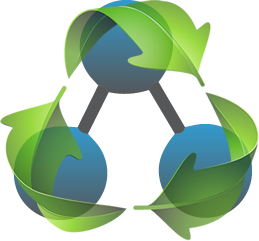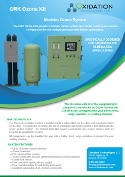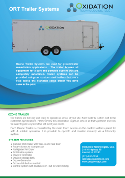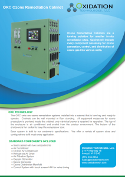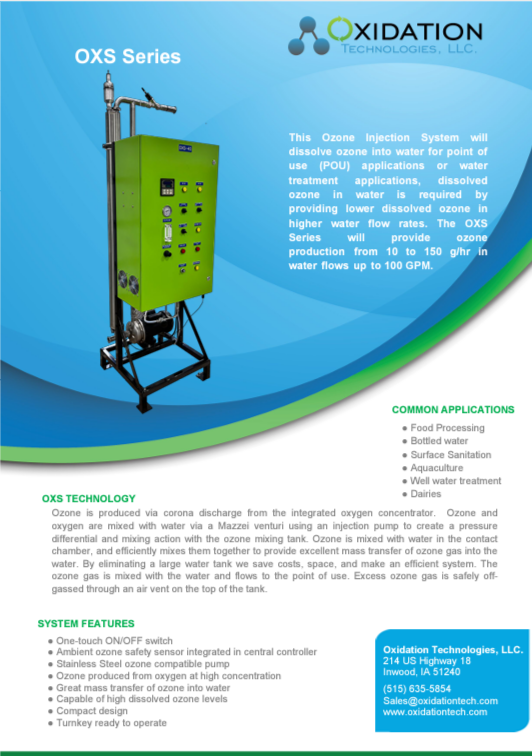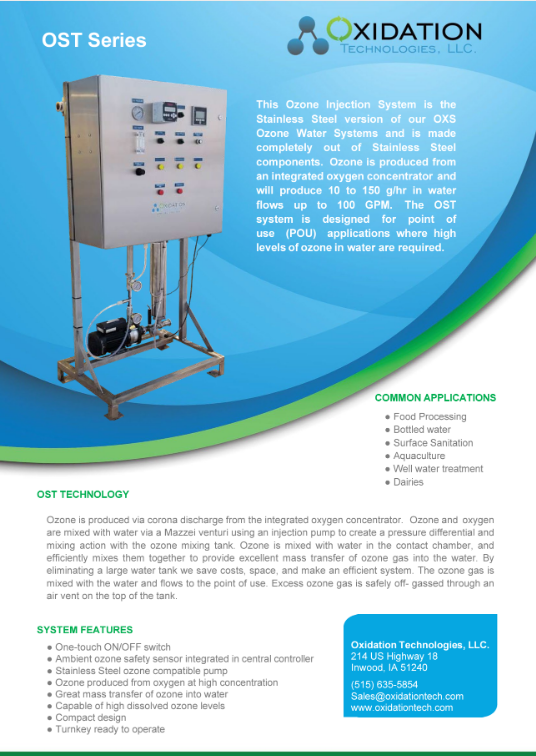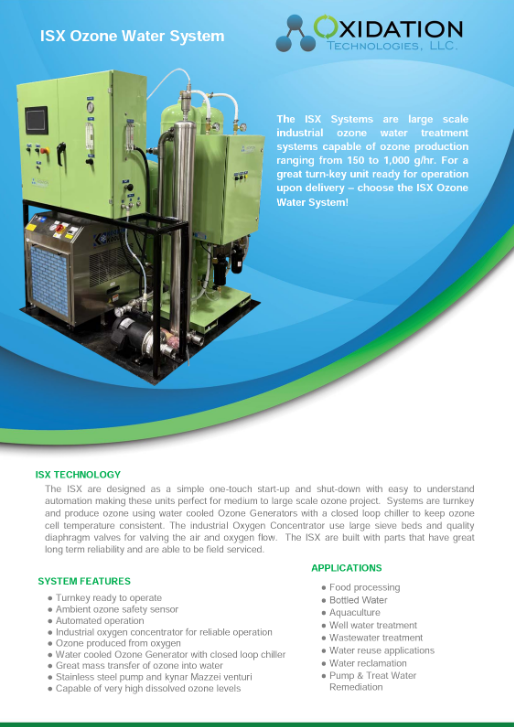1,4-Dioxane removal with ozone
The removal of 1,4 Dioxane as a groundwater and drinking water contaminate has recently gained a great deal of traction. Due to new regulations on 1,4 Dioxane limits in water, there is a need to offer better solutions for 1,4 Dioxane than ever before. Ozone can be a part of the solution for either in-situ or ex-situ water treatment applications.

1,4 Dioxane has been used as a solvent in many applications and is also used as a stabilizer for chlorinated hydrocarbons. It is commonly found in water along with methyl chloroform (1,1,1-trichloroethane) where it may have been used for degreasing applications. Improvements in detection methods and awareness of the commonality in these contaminants being found together have raised the awareness of potential 1,4 Dioxane contamination in water.
1,4 Dioxane is highly soluble in water and does not bind to soils at a high rate. Therefore it may leach into groundwater faster and further down-gradient than other contaminates found in the same plume. This will make 1,4 Dioxane harder to treat with many standard treatment methods. However, as ozone is also highly soluble in water using ozone in-situ with an ozone sparging system is an excellent option for 1,4 Dioxane removal.
Levels of 1,4 Dioxane exceeding limits deemed as safe, or exceeding regulatory limits have been found in many drinking water systems around the world. As standard drinking water facility systems are not well suited for the removal of 1,4 Dioxane, new and more improved methods are needed. Ozone used with UV light for an advanced oxidation process is an excellent option for these drinking water plants.
Our Results:
We have used ozone and hydrogen peroxide, and ozone alone successfully for the removal of 1,4-Dioxane, both in-situ and pump-and-treat applications. Below are results from a recent bench test we performed prior to a larger scale on-site pilot test. This data showed that with sufficient ozone levels dissolved into water the addition of H2O2 offered little difference in VOC reduction. The first two tests used ozone at the same rates, the second test uses the same ozone dosage rates while adding H2O2 to the water.
| Test #1 used ozone gas at 6% by weight bubbled through a column of water | ||||
| Test #1 | Test #1 | Test #1 | ||
| VOC | 0 min | 10 Minutes | 20 Minutes | 30 Minutes |
| 1,1,1-Trichloroethane | 66 ppb | 4.5 ppb | 0.31 ppb | 0.28 ppb |
| 1,1-Dichloroethane | 380 ppb | 50 ppb | 9.6 ppb | 0.93 ppb |
| 1,1-Dichloroethene | 140 ppb | 0.34 ppb | 0.34 ppb | 0.34 ppb |
| 1,4-Dioxane | 120 ppb | NR | NR | NR |
| Tetrachloroethene | 140 ppb | 0.12 ppb | 0.12 ppb | 0.12 ppb |
| Trichloroethene | 410 ppb | 0.22 ppb | 0.22 ppb | 0.22 ppb |
| Test #2 used identical parameters to Test #1 to duplicate test and verify results | ||||
| Test #2 | Test #2 | Test #2 | ||
| VOC | 0 min | 10 Minutes | 20 Minutes | 30 Minutes |
| 1,1,1-Trichloroethane | 66 ppb | 6.2 ppb | 0.41 ppb | 0.28 ppb |
| 1,1-Dichloroethane | 380 ppb | 59 ppb | 11 ppb | 1.6 ppb |
| 1,1-Dichloroethene | 140 ppb | 0.34 ppb | 0.34 ppb | 0.34 ppb |
| 1,4-Dioxane | 120 ppb | NR | NR | NR |
| Tetrachloroethene | 140 ppb | 0.12 ppb | 0.12 ppb | 0.12 ppb |
| Trichloroethene | 410 ppb | 0.22 ppb | 0.22 ppb | 0.22 ppb |
| Test #3 used identical parameters as Test #1 & 2 with the addition of H2O2 | ||||
| Test #3 | Test #3 | Test #3 | ||
| VOC | 0 min | 10 Minutes | 20 Minutes | 30 Minutes |
| 1,1,1-Trichloroethane | 66 ppb | 1.8 ppb | 0.28 ppb | 0.28 ppb |
| 1,1-Dichloroethane | 380 ppb | 0.87 ppb | 0.24 ppb | 0.24 ppb |
| 1,1-Dichloroethene | 140 ppb | 0.34 ppb | 0.34 ppb | 0.34 ppb |
| 1,4-Dioxane | 120 ppb | NR | NR | NR |
| Tetrachloroethene | 140 ppb | 0.12 ppb | 0.12 ppb | 0.12 ppb |
| Trichloroethene | 410 ppb | 0.22 ppb | 0.22 ppb | 0.22 ppb |
In all three tests the level of 1,4-Dioxane in water was reduced from 120 ppb to 0 with every ozone dosage rate and with the addition of H2O2. Other VOC's were also in this water and reduced along with 1,4-Dioxane. All VOC's were reduced to well below minimum standards in this bench test. Subsequent work on this site achieved similar results.
In-Situ Remediation:
For in-situ chemical oxidation applications, we offer a variety of systems and options. Complete turn-key trailers are commonly used. We also offer modular system to allow the end-user to install the system in an existing enclosure on-site. This may be helpful for a retrofit, or to lower costs by using existing infrastructure.
In these applications, ozone is produced as a gas from oxygen. This ozone is pushed through tubing to the bottom of a well and diffused at the bottom of the well in the water table. Ozone will dissolve into water in an area around each well treated breaking down the 1,4 Dioxane in that area. The ozone system will normally treat multiple wells on a single site by switching between wells periodically. As ozone has a half-life and will continue to break-down 1,4 Dioxane after sparging is shut-off there is added benefit to treating 15 wells with a system that has the capability of sparging to only 5 wells at a time.
Pilot systems are also available for In-situ remediation for short-term tests. We currently have ozone trailers available for these applications
All new ozone systems for remediation applications
Pilot systems currently available
Pump and Treat:
This refers to any system that will treat water in a flow or process. We offer ozone injection systems that are typically skid mounted to be installed in existing infrastructure. A standard ozone water system will consist of an ozone generator that generates ozone from oxygen, an ozone injection pump and venturi to dissolve ozone gas efficiently into water and an ozone mixing tank to allow ozone gas time to dissolve into water, while off-gassing excess ozone from the process.
Very little contact time is required for 1.4 Dioxane reduction in water. What is needed is high dissolved ozone levels for maximum oxidation potential or the addition of a UV light to create the Advanced Oxidation Process that will create the Hydroxyl Radical in water. Exact ozone dosage rate, contact time, and technology used should be based upon the levels of 1,4 Dioxane in water and the other potential contaminants found in the water.
Pilot test systems are available, we can also provide bench-scale testing services to determine if ozone is a viable option for your water.
Pilot test system for rent currently available
Technical Documents:
Below is a series of papers and documents outlining practical and laboratory success in the elimination of 1,4 Dioxane from water using ozone, or ozone AOP processes.
Oxidation and Biodegradability Enhancement of 1,4-Dioxane Using H2O2 and Ozone
Combined Ozone and Ultrasound for the Removal of 1,4-Dioxane from Drinking Water
Evaluation of Ozone and AOP for Degradation of 1,4-Dioxane in water
EPA Presentation on ozone and AOP for 1,4 Dioxane
Treatment of 1,4-Dioxane in Groundwater using AOP: UV/Peroxide, Ozone Peroxide
Winning the Battle Against 1,4-Dioxane with Ozone Advanced Oxidation



